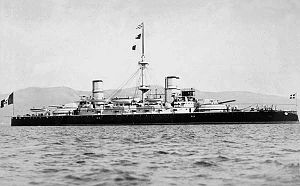
SMS Leopard was a torpedo cruiser (Torpedoschiff) of the Austro-Hungarian Navy. She and her sister ship, SMS Panther, were part of a program to build up Austria-Hungary's fleet of torpedo craft in the 1880s. Both ships, the only members of the Panther class, were built in Britain at the Armstrong shipyard in Elswick. Leopard was laid down in January 1885, launched in September 1885, and completed in March 1886. She was armed with a battery of two 12 cm (4.7 in) guns and ten 47 mm (1.9 in) guns, along with four 356 mm (14 in) torpedo tubes.

Ammiraglio di Saint Bon was a pre-dreadnought battleship of the Regia Marina built during the 1890s. She was laid down in July 1893, launched in April 1897, and completed in May 1901. She was the lead ship of her class, and had one sister ship, Emanuele Filiberto. The ship was armed with a main battery of four 254 mm (10 in) guns and was capable of a top speed of 18 knots.
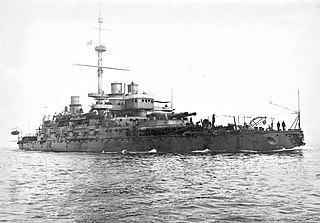
The Re Umberto class were a group of three ironclad battleships built for the Italian Navy in the 1880s and 1890s. The ships—Re Umberto, Sicilia, and Sardegna—were built as the culmination of a major naval expansion program begun in the 1870s following Italy's defeat at the Battle of Lissa in 1866. The Re Umbertos incorporated several innovations over previous Italian designs, including a more efficient arrangement of the main battery, installation of wireless telegraphs, and in Sardegna, the first use of triple-expansion steam engines in an Italian capital ship. Designed by Benedetto Brin, they retained the very thin armor protection and high top speeds of his earlier designs.

Re Umberto was a Re Umberto-class ironclad battleship built for the Italian Regia Marina in the 1880s, the lead ship of her class. She was laid down in July 1884 and launched in October 1888; work proceeded so slowly that she was not finished until February 1893. She was armed with a main battery of four 343 mm (13.5 in) guns and had a top speed of 20.3 knots, though this high speed came at the cost of armor protection.

Sicilia was the second of three Re Umberto-class ironclad battleships built for the Italian Regia Marina. The ship, named for the island of Sicily, was laid down in Venice in November 1884, launched in July 1891, and completed in May 1895. She was armed with a main battery of four 343 mm (13.5 in) guns and had a top speed of 20.3 knots, though this high speed came at the cost of armor protection.

The Emanuele Filiberto was a pre-dreadnought battleship built for the Italian Navy during the 1890s. Her keel was laid down in October 1893 and she was launched in September 1897; work was completed in April 1902. She had one sister ship, Ammiraglio di Saint Bon, the lead ship of the Ammiraglio di Saint Bon class. She was armed with a main battery of four 254 mm (10 in) guns and was capable of a speed in excess of 18 knots.

Regina Elena was the lead ship of her class of pre-dreadnought battleships built for the Italian Regia Marina. The ship was built by the La Spezia shipyard between 1901 and 1907, and was armed with a main battery of two 305 mm (12 in) guns and twelve 203 mm (8 in) guns. She was quite fast for the period, with a top speed of nearly 21 knots. Regina Elena was active in both the Italo-Turkish War with the Ottoman Empire in 1911–1912, where she participated in the Italian conquest of Cyrenaica, and World War I in 1915–1918, where she saw no action due to the threat of submarines in the narrow confines of the Adriatic Sea. She was retained for a few years after the war, but was ultimately stricken in February 1923 and broken up for scrap.

Vittorio Emanuele was an Italian pre-dreadnought battleship, laid down in 1901, launched in 1904 and completed in 1908. She was the second member of the Regina Elena class, which included three other vessels: Regina Elena, Napoli, and Roma. Vittorio Emmanuele was armed with a main battery of two 305 mm (12 in) guns and twelve 203 mm (8 in) guns. She was quite fast for the period, with a top speed of nearly 21 knots.

Roma was an Italian pre-dreadnought battleship, laid down in 1903, launched in 1907 and completed in 1908. She was the third member of the Regina Elena class, which included three other vessels: Regina Elena, Napoli, and Vittorio Emanuele. Roma was armed with a main battery of two 305 mm (12 in) guns and twelve 203 mm (8 in) guns. She was quite fast for the period, with a top speed of nearly 21 knots.

Italia was an Italian ironclad battleship built for the Italian Regia Marina, the lead ship of the Italia class. She and her single sister ship, Lepanto, had lengthy construction times. Italia was laid down in January 1876, launched in September 1880, and completed in October 1885. She was armed with a main battery of four 432 mm (17 in) guns mounted in a central barbette and was capable of a top speed of 17.8 knots. Unusually for ships of that era, Italia had an armored deck rather than the typical belt armor.
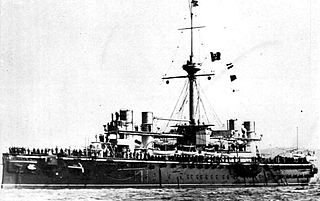
Lepanto was an Italian ironclad battleship built for the Italian Regia Marina, the second and last ship of the Italia class. Lepanto was laid down in November 1876, launched in March 1883, and completed in August 1887. She was armed with a main battery of four 432 mm (17 in) guns mounted in a central barbette and was capable of a top speed of 17.8 knots. Unlike other capital ships of the era, Lepanto had an armored deck rather than the more typical belt armor.

Ruggiero di Lauria was an ironclad battleship built in the 1880s for the Italian Regia Marina. She was the lead ship of the Ruggiero di Lauria class, which included two other ships, Francesco Morosini and Andrea Doria. Ruggiero di Lauria, named for the medieval Sicilian admiral Ruggiero di Lauria, was armed with a main battery of four 432 mm (17 in) guns, was protected with 451 mm (17.75 in) thick belt armor, and was capable of a top speed of 17 knots.

Andrea Doria was an ironclad battleship built for the Italian Regia Marina in the 1880s and 1890s. Named for the 16th-century Genoese admiral Andrea Doria, she was the third and final ship of the Ruggiero di Lauria class. The ship was armed with a main battery of four 432 mm (17 in) guns, was protected with 451 mm (17.75 in) thick belt armor, and was capable of a top speed of 17 knots.

Piemonte was a unique protected cruiser built for the Italian Regia Marina in the 1880s by the British shipyard Armstrong Whitworth. She was the first major warship armed entirely with quick-firing (QF) guns and she was also the fastest cruiser in the world upon her completion in 1889. Piemonte was frequently deployed overseas, including a lengthy tour in East Asian waters from 1901 to 1904. She saw significant action during the Italo-Turkish War in 1911–1912 in the Red Sea, where she frequently bombarded Ottoman ports. During the Battle of Kunfuda Bay in January 1912, she and two destroyers sank four Ottoman gunboats and forced ashore three more. Piemonte participated in World War I but she saw little action during the conflict. She remained in service until 1920, when she was scrapped.
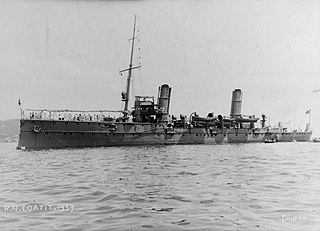
Coatit was a torpedo cruiser of the Italian Regia Marina built in the late 1890s. She was the second and final member of the Agordat class. The ship, which was armed with twelve 76 mm (3 in) guns and two 450 mm (17.7 in) torpedo tubes, was too slow and short-ranged to be able to scout effectively for the fleet, so her career was limited. She saw action during the Italo-Turkish War in 1911–1912, where she provided gunfire support to Italian troops in North Africa. She also caused a minor diplomatic incident from an attack on retreating Ottoman soldiers in Anatolia. Coatit was part of an international fleet sent to Constantinople when the city appeared to be at risk of falling to the Bulgarian Army during the First Balkan War. In 1919, she was converted into a minelayer and was sold for scrap in 1920.
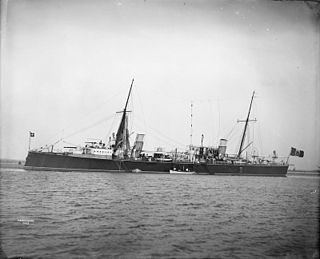
Partenope was a torpedo cruiser built for the Italian Regia Marina in the 1880s, the lead ship of her class, which included seven other vessels. The ship was built by the Regio Cantiere di Castellammare di Stabia; she was laid down in June 1888, was launched in December 1889, and was completed in September 1890. Her main armament were her five torpedo tubes, which were supported by a battery of ten small-caliber guns.
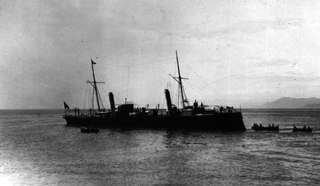
Minerva was a torpedo cruiser of the Partenope class built for the Italian Regia Marina in the 1880s. The second of eight ships, Minerva was built by Gio. Ansaldo & C.; her keel was laid down in February 1889, she was launched in February 1892, and she was commissioned in August that year. Her main armament were her five torpedo tubes, which were supported by a battery of ten small-caliber guns. Minerva spent most of her career in the main Italian fleet, where she was primarily occupied with training exercises. She was converted into a minelayer in 1909–1910. She did not see significant action during the Italo-Turkish War in 1911 or World War I in 1915–1918, though she was used to lay defensive minefields during the latter conflict. The ship was sold for scrap in 1921.

Iride was a torpedo cruiser of the Partenope class built for the Italian Regia Marina in the 1880s. Laid down in February 1889 at the Regio Cantiere di Castellammare di Stabia shipyard, she was launched in July 1890 and was commissioned in November 1892. Her main armament were her six torpedo tubes, which were supported by a battery of ten small-caliber guns. Iride spent most of her career in the main Italian fleet, where she was primarily occupied with training exercises. During the Italo-Turkish War in September 1911, she remained in Italian waters until late in the conflict; she escorted a troop convoy to North Africa in April 1912 and bombarded Ottoman positions in June and July. Iride was eventually broken up for scrap in December 1920.

Goito was a torpedo cruiser built for the Italian Regia Marina in the 1880s. She was the lead ship of the Goito class, which included three other vessels. Goito was built by the Regio Cantiere di Castellammare di Stabia shipyard between September 1885 and February 1888. She was armed with a variety of light guns and five 14-inch (356 mm) torpedo tubes, and was capable of a top speed of 18 knots. The ship served the duration of her career in the main Italian fleet. Her early service was primarily occupied with training exercises; front-line duties ended in 1897 when she was converted into a minelayer, though she continued to participate in fleet exercises. During World War I, Goito laid defensive minefields in the Adriatic Sea. She was eventually sold for scrap in 1920 and broken up.
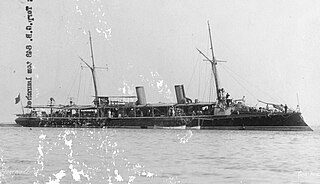
Tripoli was the first modern torpedo cruiser built for the Italian Regia Marina. She was built by the Regio Cantiere di Castellammare di Stabia shipyard in 1885–86. The only vessel of her class, she provided the basis for the Goito and Partenope classes that followed. She was armed with five 14-inch (356 mm) torpedo tubes and a battery of light guns, and was capable of a top speed of 17.5 knots. Tripoli spent her career in the main Italian fleet, where she was occupied primarily with peacetime training exercises. She was modernized several times throughout her career, and in 1910, was converted into a minelayer, a role she served in for another thirteen years, including during World War I. She was the longest serving torpedo cruiser in the Italian fleet, with over 36 years in service by the time she was discarded in March 1923.
